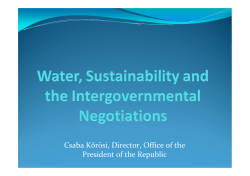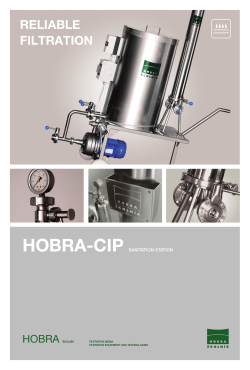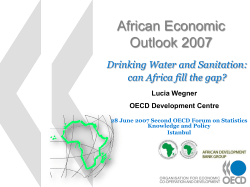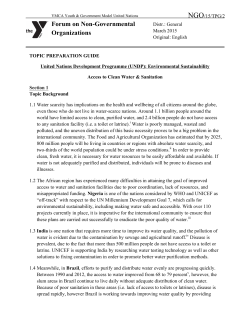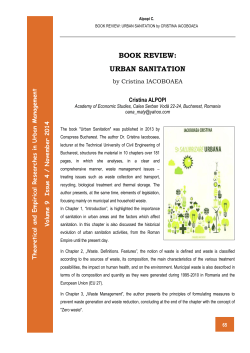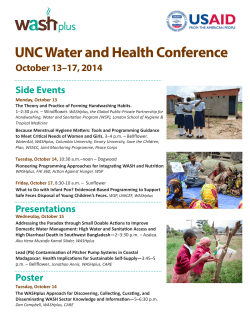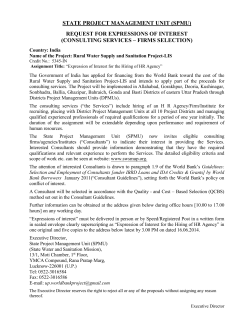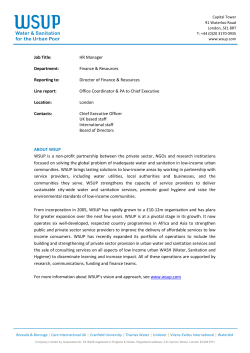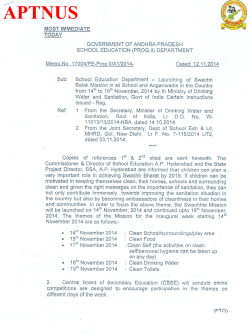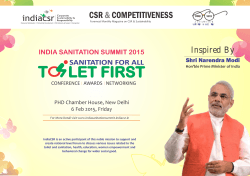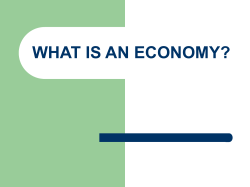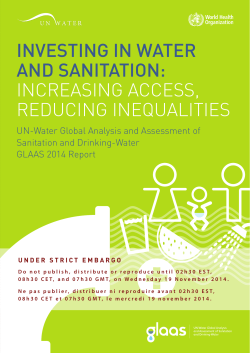
Heterogeneity of small settlements
Strategic Environmental Sanitation Planning Small-Scale Sanitation in Egypt: Towards a Data Baseline for Action The SECO-funded ESRISS Project is working on the sound development of small-scale sanitation for settlements in Egypt’s Nile Delta. This article summarizes its published report [1], which makes a strong data set available, as well as recommendations for planners and designers. P. Reymond1, C. Demars2, A. Papangelou2, M.H. Tawfik3, R. A.Wahaab4, M. Moussa5 Heterogeneity of small settlements Colin Demars Our fieldwork showed that the small settlements in the Nile Delta (ezbas and villages) are very heterogeneous and that this heterogeneity requires that sanitation options be selected and designed on a case by case basis (See Photo 3). Determining the design parameters and most cost- effective sanitation options required assessing the following factors for each settlement: density and shape, proximity to drains or canals, the groundwater table, the quality of the water supply and the number of animals per household. Statistics regarding the population number and the water consumption of the settlements were found to be unreliable and had to be determined first - hand. The skills, capacities and willingness to participate in sanitation planning differed significantly from village to village. Our work found that involving key village sanitation stakeholders in the planning process from the start should be encouraged. In addition, sanitation management schemes should be dis- The development of sound sanitation strategies for settlements under 5 000 inhabitants in the Nile Delta has been limited due to the lack of baseline data and of design parameters characterising rural wastewater [2, 3]. To address this need, the ESRISS Project produced a data baseline under the auspices of SECO’s institutional support to the Egyptian Holding Company of Water and Wastewater (HCWW). The objectives were to: (i) gather all information available and reference it in one report; (ii) provide data based on analyses of sewage, septage and animal manure samples; (iii) describe current sanitation practices in Nile Delta villages, including household - level behaviours and pit emptying activities; (iv) analyse the factors influencing wastewater quantities and characteristics; (v) describe the existing water and nutrient reuse practices; (vi) quantify the sanitation - related financial flows; and (vii) develop a model to quantify and characterise wastewater at the village level, without sampling. This required extensive field work that included: semi - structured interviews with key sanitation stakeholders (village authorities, emptying service providers, farmers, and sewer operators), household surveys, and sampling campaigns with portable lab equipment (See Photos 1 and 2). The field work was carried out in partnership with HCWW and the Affiliated Company in the Beheira Governorate (BWADC). 16 Sandec News 15 / 2014 Colin Demars Photo 1: A household survey in Beheira Governorate. Photo 2: Septage sampling. cussed and validated before selecting the final technical options. Unequal costs of water and sanitation services Our research indicated that drinking water and sanitation costs vary from settlement to settlement. Villagers with traditional pits pay very high emptying costs that can be 20 times higher than the price paid by households connected to governmental sewer networks. The latter pay an insignificant amount for wastewater services, reflecting the high inequality between served and unserved areas. Many communities decided to fund the construction of basic “informal” sewer systems to eliminate the burden of pits (high emptying frequency, high costs, and high potential of contaminating the water available for consumption). While our data showed that this investment is quickly offset, the lack of technical expertise often turned these construction initiatives into future problems (See adapted from Google Earth Septage management Photo 3: Heterogeneous small settlements in Beheira Governorate. Photo 4). Investments in proper “shallow sewer” systems should be encouraged. If the initial investment is too high to be paid all at once, leasing mechanisms could be instituted to make the monthly payments less than pit emptying costs. ESRISS promoted HCWW’s decision taken in 2012 under the auspices of the Ministry of Water and Sanitation Utilities to provide technical support to communities willing to pay for sewer systems. This HCWW program was cancelled, however, after the last regime change in summer 2013. Regarding the price of drinking water, results showed that villagers pay significantly more than the official tariff. Research showed, however, that the rate in the water bills did not match the actual water consumption. Water readings and bills should be regularly crosschecked, and compared with the rate charged by the Affiliated Companies. On the positive side, our findings indicate that people are actually ready to pay more than the official tariff. Our work found that most pit emptying is mechanically done by trucks, which transport and discharge the septage in the nearest drains. Although the Village Councils usually own one truck, most are privately owned. It is, thus, mainly an informal private business. ESRISS recommends building proper septage disposal points, including primary treatment facilities, as a cost - effective way to reduce the contamination loads in water bodies. Private service providers could pay a small fee to discharge at the facilities to cover the O&M costs. Farmers’ interest in organic fertilisers Our research indicated that Egyptian farmers have a strong interest in organic fertilisers, i.e., sludge, manure and compost. Because of this, the selection of sanitation systems should be geared towards those that best conserve nutrients and produce good quality fertiliser material. Small scale systems are particularly apt as the sludge in small settlements is not contaminated by industrial activities and the product can be reused on- site by the villagers. ESRISS recommends that good quality compost be produced at the farm level, and advocates techniques that insure the production of well stabilised sludge. Unrealistic laws and regulations Existing laws and regulations were found to be not well suited to the needs of small settlements. Often, stringent regulations “kill” simple but robust solutions and induce complex and costly options that do not work in the long term. The regulations’ main limiting factor is the COD value (80 mg /L), which is significantly lower than the European Union standard (125 mg /L). The presently promoted dissolved oxygen level (> 4 mg /L) is also a major limiting factor as it forces the implementation of a costly aerobic treatment step. ESRISS recommends the work being done in Jordan and Morocco because both have instituted much more pragmatic standards (250 mg /L COD in Morocco and 300 mg /L COD for biological treatment in Jordan). Morocco is presently employing an incremental approach to implement these standards, and this same approach could be very effectively applied to Egyptian rural areas. Conclusion ESRISS’s present objective is to financially analyse the sanitation supply chain and finalise a simplified tool that practitioners can use to assess the quantities and characteristics of the wastewater to be treated at the village level in the Nile Delta. Useful tools for preliminary sanitation assessments have been developed, such as semi- structured interview guidelines and a household survey questionnaire (both in English and Arabic). ESRISS recommends that a similar data baseline be created for the Upper Egypt region, where the situation is different than in the Nile Delta. Combining the research results of these two regions would provide a strong basis towards the development of national policies and guidelines. [1] Reymond, Ph., Demars, C., Papangelou, A., Hassan Tawfik, M., Abdel Wahaab, R., and Moussa, M. (2013): Small-Scale Sanitation in the Nile Delta: Baseline Data and Current Practices. Eawag, Switzerland-Egypt. [2] Reymond, Ph., Abdel Wahaab, R., and Moussa, M. (2012): Small-scale Sanitation in Egypt – 10 Points to Move Forward. Research for Policy Brief. Eawag, Switzerland-Egypt [3] Reymond, Ph. (2012): Small-scale Sanitation in Egypt: Challenges and ways forward. Eawag, Switzerland-Egypt. 1Eawag/Sandec, 2EPFL Switzerland / ETHZ 3ESRISS Project Assistant 4Holding Company for Water and Wastewater, Egypt 5Helwan University, Egypt We would like to thank all of our Egyptian partners and colleagues for their support, and the Swiss State Secretariat for Economic Affairs (SECO - www.seco-cooperation.ch) for funding this project. Lukas Ulrich For more information and download of the documents & tools: www.sandec.ch/esriss Photo 4: Villager unclogging a sewer pipe. Contact:philippe.reymond@eawag.ch, based in Cairo Sandec News 15 / 2014 17
© Copyright 2025
